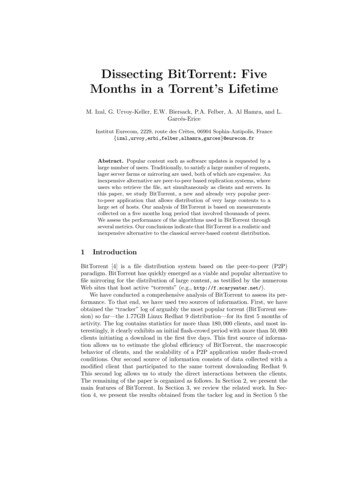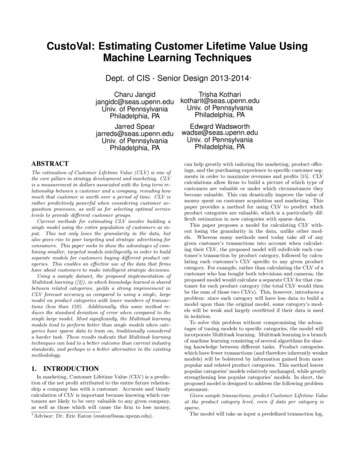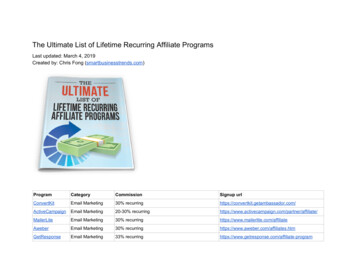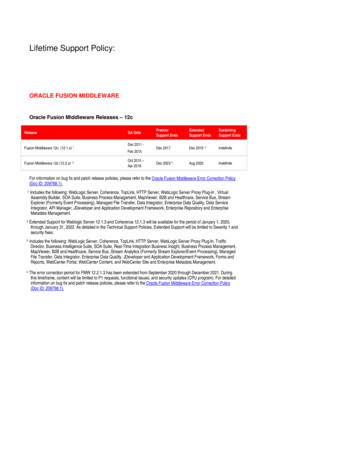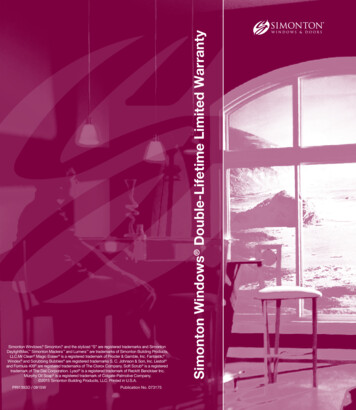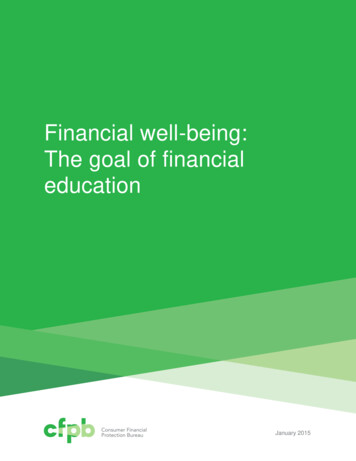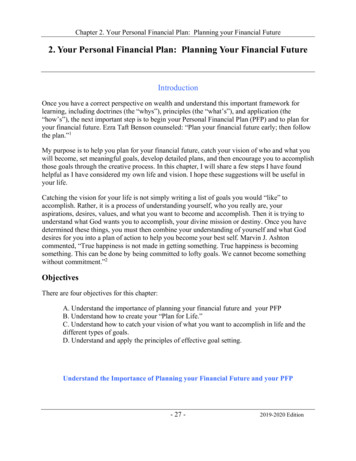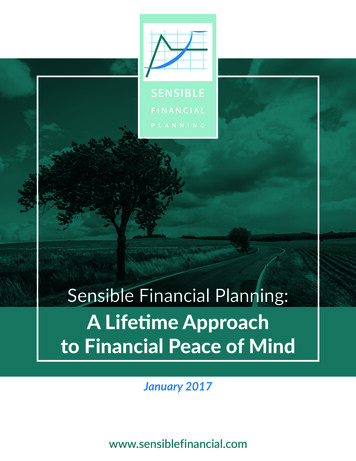
Transcription
Sensible Financial Planning:A Lifetime Approachto Financial Peace of MindJanuary 2017www.sensiblefinancial.com
Sensible Financial Planning:A Lifetime Approach to Financial Peace of Mindwww.sensiblefinancial.comThe basic financial planning problem is simple: you’ll live longerthan you work. You’ll have to move income you earn while you’reworking into your retirement, when you’re not working or earning.The best financial planning goes beyond those basics, however.Your lifetime plan should help you reach your life goals, not justyour financial goals. Your quality of life depends on factors that gobeyond your financial spending power. Your health, relationshipsand family are all extremely important.Sacrificing now so you can live better later isn’t attractive. Forexample, working longer to fund your retirement may cause youto miss opportunities to spend time with family, to travel, or toundertake charitable or other activities. A decline in lifestyle oncethe paychecks stop arriving isn’t attractive either.Conceptually, your Sensible Financial plan is very simple. It beginswith your life goals and financial resources. It adds up all yourfinancial resources and subtracts the costs of your goals. Thedifference is available for everyday living. At your sustainable livingstandard, you spend that “everyday living budget” evenly over yourlifetime.Matching your financial resources and sustainable living standardwith your life goals produces a saving plan to build the assets youwill accumulate over your lifetime. You will draw upon those assetsto pay for later one-time financial goals (such as college for yourchildren or a down payment on a second home) and throughoutyour retirement.Developing a solid financial plan can be analytically complex,but the plan itself can be simple and clear. We believe that if youunderstand your financial plan so that you can feel comfortablewith it, you’ll actually use it.IntroductionLife Phases and Financial IssuesFrom the perspective of financial planning, you can look at your lifeas a series of phases. Each phase offers its own opportunities, andposes its own set of challenges.In reality, your life phases are not neatly distinct from each other. Theymay overlap or occur in different sequence. Some may even recur.1SensibleStoriesAdam and JenniferBy Frank Napolitano, SeniorFinancial AdvisorAdam had just turned 40 andwas a successful engineer.Jennifer left the workforce a fewyears earlier to raise their threechildren. They had many reasonsfor making a financial plan, butthe one issue that kept comingup was the relationship withtheir current advisor. They wereconcerned that their portfoliohadn’t grown as it should.Even though their advisor wasprimarily a money manager,they found it hard to speak withhim about their investments.Conversations were friendly butnot substantive. And worst of all,they didn’t understand how theywere being charged. They wantedsome level of fee transparency.There are several broadcategories of fee arrangements.Fee-only financial advisorsare compensated solely fromfees that clients pay (directly)to the advisors. In contrast,commission-based advisorsare compensated based onthe financial products thatthey sell. (“Fee-based” advisorscharge a client fee and receive
Sensible Financial Planning:A Lifetime Approach to Financial Peace of Mindcompensation from sellingproducts, not to be confusedwith “fee-only”). Adam andJennifer decided that theypreferred a fee-only arrangementas being less likely to lead toconflicts of interest in productrecommendations.Secondly, there are twostandards of care in the financialindustry. A fiduciary standardrequires that an advisor act ina client’s best interest. It is thehighest standard of care underthe law. Alternatively, a financialadvisor may be subject to asuitability standard. Under thisstandard, an advisor need onlymake recommendations that aresuitable based on the client’ssituation. Recommendationsdon’t have to be in the client’sbest interest. Adam and Jennifer,who hadn’t been aware of thedistinction, decided that theypreferred a fiduciary advisor.www.sensiblefinancial.comWhen you start to plan, it’s helpful to identify which phase you arein, and which elements of that phase are most relevant to you.We’ll use the following seven phases to organize the discussion:1. School2. Young adulthood3. Committed adulthood4. Child rearing5. Pre-retirement6. Early retirement7. Late retirementIn addition, four financial issues are common to all phases of your life:Human Capital ManagementLiving within Your MeansCash FlowAsset AllocationFrank NapolitanoSenior Financial Advisor2
Sensible Financial Planning:A Lifetime Approach to Financial Peace of Mindwww.sensiblefinancial.comHuman Capital ManagementAs we’ll see, the school phase is all about Human CapitalManagement. Once you leave school, you continue to makedecisions about your human capital – where to work (which job totake) and how to advance your career. Human capital managementhas a major influence on your financial life – it largely determinesthe financial resources you will have. You decide whether to takethe remunerative job that requires you to travel and work longhours or the one where you earn less but have a more attractivework/life balance. You decide whether or not to accept projectsthat will require you to work late, whether or not to acceptpromotions or transfers to other cities. You decide whether totake time away from work to raise your children or to care for yourparents. These decisions affect both the money that you earn at thetime and your future earnings as well – your work experience andyour network of work relationships are important factors in yourearnings growth.Living within your meansYou can’t spend more than the resources available to you. Thissounds deceptively simple. Unless you can figure out how to diebankrupt (owing more than you own), you can’t spend more in yourlifetime than you earn (plus any gifts you receive or inherit). So,this is something you are forced to do. How hard can it be? Twofactors contribute to the complexity of living within your means:credit and lifetime budgeting. Being able to borrow allows you tospend tomorrow’s money today. If you do too much of that, you’llfind out tomorrow that you have fewer resources left to spendthan you thought you might. Lifetime budgeting requires saving forretirement, spending less today so that you’ll have something left tospend when you are no longer earning.3Third, there are two broadlydifferent approaches to mutualfund management – activeand passive. For a long time,the passive approach has beengrowing and the active approachhas been shrinking. Academicanalysis strongly suggests thatpassive funds tend to producehigher net returns, primarilybecause they are less expensiveto operate. In addition, they tendto be less risky than activelymanaged funds (they have less“tracking error”). Neither Adamnor Jennifer is a financial expert,but both understood that feesmatter. They admitted that theydidn’t even know their currentfunds had fees. We showedthem how easy it is to look upthe information themselves onMorningstar or Yahoo Finance.A detailed analysis of theircurrent holdings revealed thatthey were paying over 3% in feesannually. The mutual funds theyowned had an average expenseratio of 1.4%. Additionally, theiradvisor was charging an advisoryfee of about 2.25%. Adam andJennifer felt embarrassed thatthey had no idea how muchthey were paying their advisor.Nothing to be embarrassedabout, since many, perhapsmost, people do not understandhow their financial advisors arecompensated. Unfortunately,
Sensible Financial Planning:A Lifetime Approach to Financial Peace of Mindthere’s an incentive in thefinancial services industry toobscure fees and distract clientsfrom what’s going on in terms ofreturn.Like every family, Adam andJennifer still have financial issues,but understanding their fees isnot one of them.www.sensiblefinancial.comCash flowManaging cash flow just means making sure that the money youwant to spend is available when you want to spend it. If you havesavings that are illiquid, e.g., a house or a retirement account, youmay be living comfortably within your means (not planning tospend more in your lifetime than you can afford), and yet not beable to come up with any cash. This can force you to borrow whenyou’d prefer not to, or simply to do without. It’s helpful to have anemergency fund – readily available cash – to help you deal withsituations you don’t expect and can’t predict. An emergency fundcan enable you to meet such situations with confidence, if notexactly with a smile on your face.Asset allocationAsset allocation is choosing how best to invest your savings sothat the resources you need will be available when you need them.This includes being sure that you have an emergency fund largeenough to allow you to cope with unforeseen contingencies. Italso means deciding how much you invest in stocks and bonds inyour retirement accounts and in your other investment accounts.Doing asset allocation well requires understanding both your riskcapacity (how much you can afford to lose) and your risk tolerance(how much you could bear to lose). Your ideal asset allocationvaries throughout your life. In your early working years, your humancapital or earning power represents a very large proportion of yourwealth, significantly larger than your financial assets. In this phase,how you invest your financial assets will have little impact on youroverall risk profile. As you get older, and save more, your humancapital diminishes in relative importance, and your stock/bondchoice looms larger.With all this in mind, let’s take a closer look at each of your lifephases.4
Sensible Financial Planning:A Lifetime Approach to Financial Peace of Mindwww.sensiblefinancial.com1. SchoolBefore you work and earn, you learn. You go to school, you go tocamp, you play sports, learn to play musical instruments – you growinto your adult self.Economists have a grand formal name for this phase – “HumanCapital Accumulation.” They’ve spent a great deal of time andeffort developing the human capital concept, and they use it toexplain many aspects of economic life including who works, howmuch they earn, and when they retire. Simply put, however, humancapital is earning power.Don and ChiyakoBy Laura Williams, JuniorFinancial AdvisorDon and Chiyako selecteda financial advisor to helpthem with a small numberof important objectives: toorganize their financial lives,to understand whether theirspending was reasonable, and toget a consolidated view of theircombined financial assets.School, even elementary school, has financial implications for you.First you learn to read, and write, and to figure (the famous threeRs, the last one being ‘rithmetic). You also learn much more that isessential to being a working adult: how to interact peacefully withothers, how to work productively with others, etc.Education is expensive. There are two broad categories of costs. Theone you usually think of is tuition (and for some higher education,room and board). Schools need places for classes to meet: buildingsand classrooms (even virtual schools need office space, productionstudios and websites). They need teachers to teach (and teachingassistants to help, and administrators to keep the school managed).And they need teaching materials – books, lesson plans, teachingapps, etc. for students and teachers to work with.The second cost is the student’s opportunity cost. You could workinstead of attending school, and the earnings that you forego inorder to study are a significant element of the total cost of youreducation. In this country, the importance of opportunity cost ismost obvious for post-secondary education. High school graduatesmay explicitly consider starting work as an alternative to attendingcollege. College graduates often take their work options intoaccount directly when considering graduate school.From a financial planning perspective, school is an investment. Thisgives rise to three questions:5Laura WilliamsJunior Financial AdvisorAs a two earner householdwith one young child, Don andChiyako have busy schedules.They were interested in gettingassistance to “steer the ship”given their financial goals. Inthe short-term, they wantedhelp with stock option planning,education planning and to worryless about their finances. Overthe long-term, they wanted tomaintain their current lifestyle,to have sufficient resources inretirement and to understand
Sensible Financial Planning:A Lifetime Approach to Financial Peace of Mindwhat asset allocation would beappropriate for them.They found that a full financialplan was a very useful constructfor accomplishing their objectivesand financial goals.First, Chiyako focused on creatinga 10b5-1 plan that would allowher to exercise stock options shereceived from her company whilecomplying with the rules againstinsider trading. This plan isupdated over time, as necessary.Next, Don and Chiyakoconsidered scenarios for theirdaughter’s education, giventheir potential retirement ages,housing, and future earnings.The analysis showed that theyhad a lot of flexibility given theircurrent and future resources.For example, there were twoeducation-related scenarios:staying in their current homeand paying for private schoolvs. moving to a different townand sending their daughter topublic school. Both scenarioswere affordable, but movingto a different town was lesseconomical than sending theirdaughter to private school.They coordinated with aninsurance broker to ensurethat they had proper insurancecoverage in case of death ordisability. The insurance brokerwww.sensiblefinancial.comWhat kind of education is right for you?You can think of this question most directly in the context of collegeand graduate school – liberal arts or engineering? Law school ormedical school? It shows up much earlier, however, even for preschool. Will your children go to pre-sc
A Lifetime Approach to Financial Peace of Mind www.om 1. School Before you work and earn, you learn. You go to school, you go to camp, you play sports, learn to play musical instruments – you grow into your adult self. Economists have a grand formal name for this phase – “Human Capital Accumulation.” They’ve spent a great deal of time and effort developing the human capital concept .


